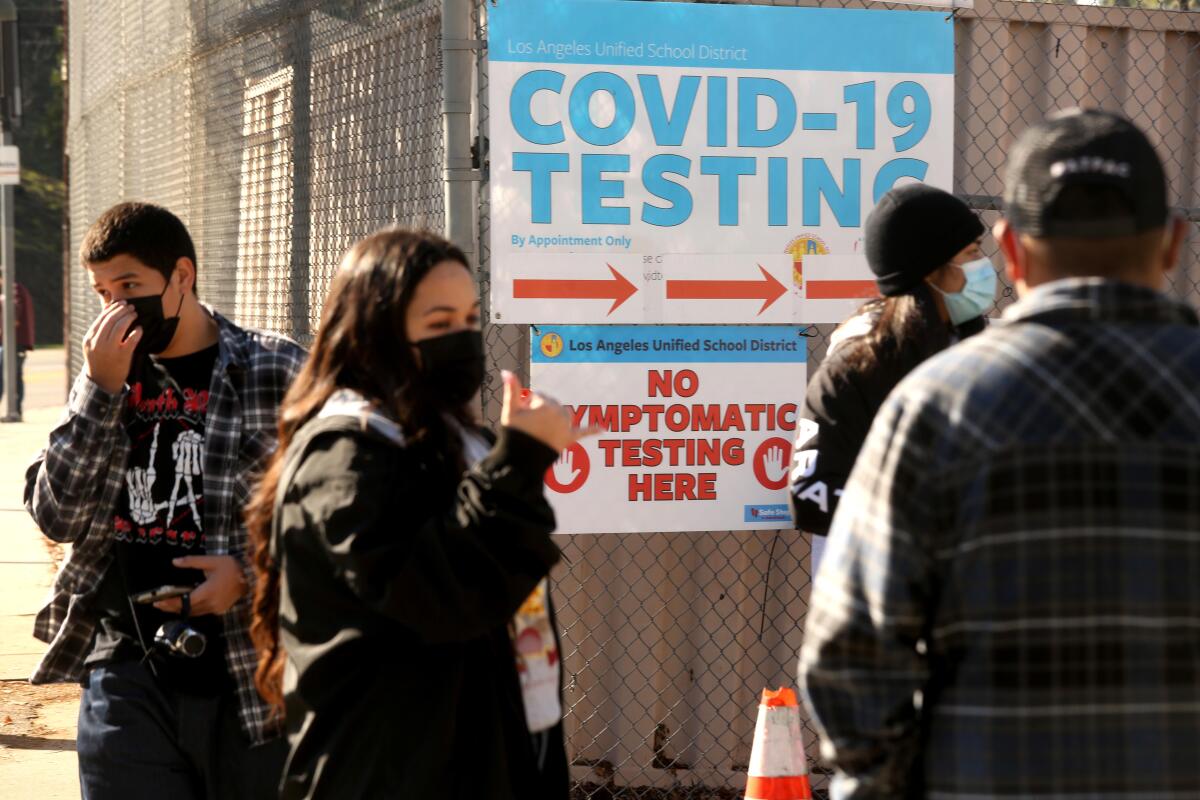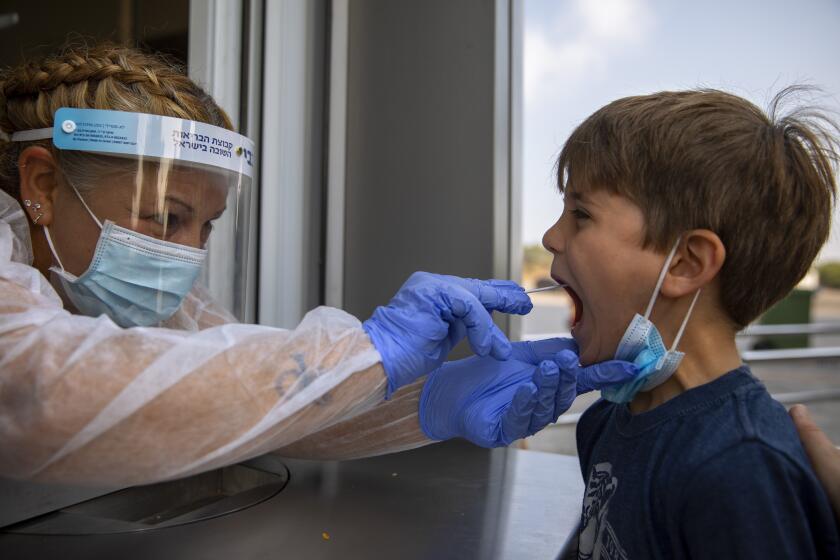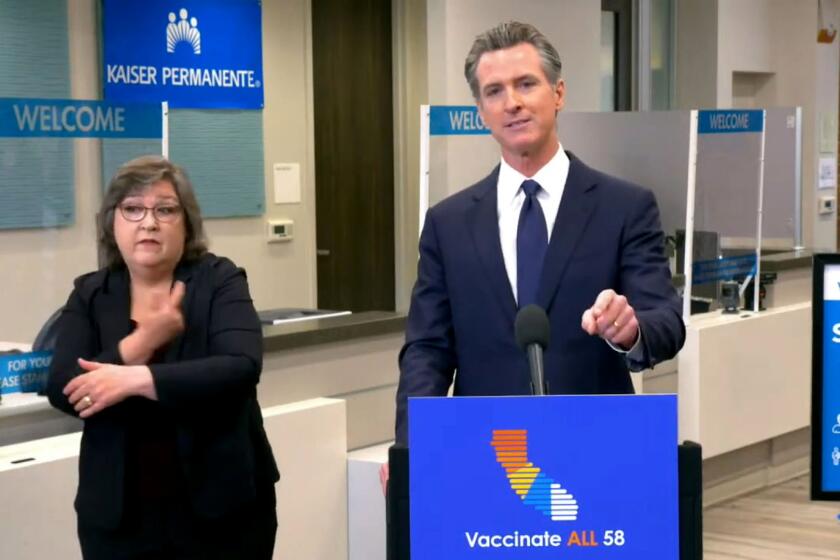Column: ‘Everybody’s getting COVID.’ That doesn’t mean you should try to get it, too

- Share via
The latest statistics are terrifying. Or, at least, they should be terrifying.
In the week after New Year’s Eve, Los Angeles County recorded roughly 174,000 cases of COVID-19 — or about 1.7% of all Angelenos. On Thursday alone, we hit a record of 37,215 new infections, mostly driven by the extraordinarily contagious Omicron variant, which now accounts for about 85% of coronavirus cases countywide. On Friday, we broke another record, with 43,712 new cases.
The surge is so bad that city officials are canceling leave, offering overtime and ordering longer shifts just to maintain public safety services while more than 1,000 cops, firefighters and paramedics are out sick with COVID-19. Emergency rooms are slammed.
Across the state and across the country, it’s much the same story.
“I don’t believe we’ve seen the peak,” Rochelle Walensky, director of the U.S. Centers for Disease Control and Prevention, told the “Today” show on Friday, adding that “hospitals right now are full of people who are unvaccinated.”
And yet, in Dr. Roberto Vargas’ corner of California in South L.A., where he’s been helping lead an effort to persuade hesitant Black and Latino residents to get vaccinated, what he hears isn’t terror over Omicron, but resignation. And, perhaps more troubling, what he increasingly hears is surrender.
“There were people who were like, ‘OK, I might have been able to hide out and safely stay away from folks, but that doesn’t seem like that’s going to matter anymore,’” Vargas told me. “So now this next wave is, ‘Everybody’s getting COVID. Why don’t I just get it?’”
If that sounds dumb and more than a little fatalistic, well, it is. About as dumb and fatalistic as taking one’s kids to a “COVID-19 party” to deliberately infect them so that, in theory, they’ll have natural immunity when, in reality, they could easily end up in intensive care.
The apparently milder Omicron variant has some parents thinking it might be helpful to let their kids get infected. But experts say there’s no upside.
Nevertheless, this relatively new mindset has created yet another challenge for public health officials trying to craft the most effective message to get people to roll up their sleeves for shots.
As a reminder, 75% of the residents of L.A. County have received at least one dose of a vaccine, 67% are fully vaccinated and about 25% have gotten a booster. But nearly half of Black and Latino residents remain unvaccinated.
The problem with Omicron is twofold.
The first part is the (evolving) thinking that it causes milder infections and is less lethal than previous variants, which is generally true, but not always, particularly among those who are not vaccinated or boosted.
Nevertheless, Vargas told me about a family member who had refused to get vaccinated and contracted COVID-19 over the holidays. Luckily, he recovered without a stint in the hospital, but took from the experience that a coronavirus infection is “not that bad.”
“I was so angry,” recalled the assistant dean at Charles R. Drew University of Medicine and Science. “It’s a hard message to give [about vaccinations] because the current observation is, well, everybody’s getting COVID, and people are looking around and seeing a lot of people get COVID and not die.”
Indeed, as of this week, county hospitals were treating only a fraction of the coronavirus-positive patients they were treating at this time last year, when the deadly Delta variant was circulating more widely than it is today.
“This can change, obviously,” L.A. County Public Health Director Barbara Ferrer warned on Thursday. “Hospitalizations are a lagging indicator. And as cases go up, shortly afterwards, we start seeing the increases in hospitalizations.”
Already, hospitals are dealing with staffing shortages of their own, as nurses and doctors call off sick.
“So that’s the real difference between what we have now and what we had, for example, when we had the Delta surge,” Ferrer explained, “where we actually had lots of patients who needed hospital care, but we didn’t have this raging rate of infection that was really making it super hard for there to be enough staff to care for people.”
That gets at the second part of the problem, which is the sense that catching COVID-19 is now inevitable, whether one is vaccinated or not.
Even I found myself slipping into this way of thinking during a trip to the Midwest over the holidays. I arrived just as the Omicron variant, which is two to four times as contagious as the Delta variant, had started surging.
Everywhere I went, people were sick. Coughing and sneezing, sniffing and blowing their noses. Every drug store I visited was sold out of cold and flu medication. Coronavirus tests of all types were impossible to come by.
There’s a white privilege to denouncing everyone who refuses to get a COVID-19 vaccine. For those who are Black, there’s systemic racism to consider.
I watched as vaccinated people who had spent months meticulously masking and social distancing all but gave up, surrendering to the inevitability of it all. Unvaccinated people, too.
I was almost ready to join them. Then I heard about my uncle. Call it a reality check.
A cancer survivor in his 70s who is vaccinated and boosted, he’d somehow gotten COVID-19. Omicron or Delta, I’m not sure. He’s now sedated on a ventilator and being pumped with bevy of drugs, some of them experimental.
In some ways, he’s lucky. He has excellent health insurance and lives across the street from a branch of the well-staffed, well-supplied Cleveland Clinic. That’s something of a privilege, particularly within the poorest Black and Latino communities.
In fact, this gets at Vargas’ main argument to young people in many neighborhoods of South L.A. who look at surging cases of Omicron and think, “Why don’t I just get it?”
Most, he knows, aren’t like my uncle with his private insurance and access to state-of-the-art hospitals. It’s quite the opposite.
“I’ve always tried to look at our data from a confluence of low rates of vaccination and no access to health care resources. And then say, OK, that pocket of geography, we really do have to do all that we can to get folks vaccinated,” Vargas said. “Because if they do get sick, they’re very likely to die because they’re not going to get to a good health center.”
As the Omicron variant infects record numbers of people, many in Southern California say they are no longer willing to hide from a virus that has already killed 800,000 Americans.
Vargas also worries about what will happen when COVID-19 moves to more of an endemic disease. Will residents in South L.A. have easy access expensive new drugs and therapies to treat COVID-19, such as Pfizer’s oral antiviral treatment Paxlovid?
“Are the pills going to be available?” he asked. “Or are, unfortunately, disparities widening?”
Add to that the prevalence of chronic diseases in South L.A., from obesity to diabetes to hypertension, and poor Black and Latino communities are at the highest risk of negative outcomes from even a mild infection of COVID-19.
Getting vaccinated is the only way to avoid some of these longstanding disparities, which continue to widen despite two-plus years of a pandemic that has exposed the healthcare system for all in government to see.
An unvaccinated person in L.A. County is 38 times more likely to need hospitalization than a person who is vaccinated and boosted, as my colleagues Luke Money and Rong-Gong Lin II reported.
“When we talk about messaging, the next wave of this narrative really has to be that the people who are being hospitalized and dying are largely the unvaccinated.”
The unvaccinated, the poor, and the Black and the Latino.
More to Read
Sign up for Essential California
The most important California stories and recommendations in your inbox every morning.
You may occasionally receive promotional content from the Los Angeles Times.














